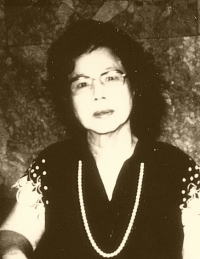Kikuko Kanai facts for kids
Quick facts for kids
Kikuko Kanai
|
|
|---|---|
 |
|
| Born | 13 March 1911 |
| Died | 17 February 1986 (aged 74) |
| Other names | 金井 喜久子 |
| Occupation | composer |
Kikuko Kanai (金井 喜久子, Kanai Kikuko, née Kawahira, 13 March 1911 – 17 February 1986) was a Japanese composer. She was one of the first Japanese women to write classical music using Western styles.
Contents
Kikuko Kanai: A Pioneer Composer
Kikuko Kawahira was born on March 13, 1911. Her birthplace was Miyako-jima, an island in Okinawa, which is part of the Ryukyu Islands. She later became known as Kikuko Kanai.
Her Early Life and Music Training
Kikuko loved music from a young age. She studied singing at the Nihon Music School. Later, she learned how to compose music at the Tokyo Academy of Music. Her teachers there were famous composers like Kanichi Shimofusa and Kishio Hirao.
When she started composing, Kikuko often used a special kind of musical scale. This was the pentatonic scale, which is common in traditional Ryukyuan music. It uses only five notes, giving the music a unique sound.
Exploring New Sounds and Achievements
In 1954, Kikuko traveled to Brazil. There, she learned about a new way of composing called the dodecaphonic method. This method uses all twelve notes of the musical scale equally, making the music sound "atonal" or without a clear key. She began to use this modern style in her own works.
Kikuko Kanai received many awards for her music. In 1955, she won the Mainichi Prize for Cultural Publication. This was a big honor for her work. Later, in 1968, the Okinawan government gave her a prize for her opera called Okinawa monogatari.
The BBC, a well-known media company, has called her "one of the first Japanese women to compose Western classical music." Kikuko Kanai passed away in Tokyo on February 17, 1986.
Her Amazing Works
Kikuko Kanai wrote many different types of music. She composed operas, ballets, and symphonies. Here are some of her important works:
- Ryūkyū no min’yō ('Folksongs of Ryūkyū') (1954)
- Okinawa monogatari (an opera)
- Miyako-jima engi (Legend of Miyako Island) (a ballet from 1949)
- Ryūkyū hiwa (A Hidden Story of Ryūkyū) (a jazz ballet from 1951)
- Hiren Karafune (Love Tragedy on Tang Boat) (an opera from 1960)
- Symphony, no.1 (1938)
- Okinawa buyō kumikyoku (Okinawan Dance Suite): no.1 (1940), no.2 (1946)
- Ryūkyū kyōsōkyoku (Ryūkyū Rhapsody) no.1 (1946)
- Symphony, no.2 (1946)
- Uruma no shi (Poem on Uruma) (1952)
- Festival Overture 'Hishō' (1972)
- Ryūkyū kyōsōkyoku no.2, for pianoforte octet (1950)
- Ryūkyū Ballade, for pianoforte (1951)
- Sonata, for violin and pianoforte (1952)
- Brazil Rhapsody, for pianoforte (1955)
- Hamachidori hensōkyoku (Variations on Hamachidori), for koto, Electone, and percussion (1970)
- Okinawa min'yō niyoru gasshōkyoku-shū (Choral Pieces on Okinawan Folksongs) (1953–60)
- Haha to ko no Okinawa no uta (Okinawan Songs for a Mother and Children) (1965)
Her music has also been released on CDs, including:
- Just For Me - Noriko Ogawa plays Japanese piano music (1997)
- Bridges to Japan (2000)

